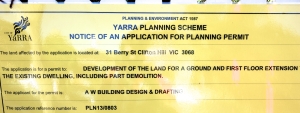Round here, the houses are distended at the rear.
Renovation has re-shaped this 1880s Melbourne suburb. Its Victorian dwellings sprout extra stories and extra rooms. Petite, period-appropriate facades give way to mega homes. (Heritage protections prevent the fronts from being changed, but that’s another story.)


This post is about why Australians don’t move.
Why, when they want more room, Australians deal with dust and noise and tradies.
It’s why Australia invented The Block: a top-rating, multi-logie award winning TV show about renovations that has spawned a global phenomenon.
The cost of moving is high and here’s the proof: 87 per cent of private renters have moved once in the last five years. Among people who own their own home the figure is 29 per cent.
Instead of moving, people renovate. 62 per cent of people live in a home that has been renovated in the last ten years, according to the most recent data (1999).
The reason is the tax on moving house. You might know it by its technical name: stamp duty.
On a $600,000 house, the tax on moving house is different in each state, according to infochoice.
ACT $22,000
NSW $22,490
NT $29,700
QLD $12,850
SA $26,830
TAS $22,500
VIC $31,070
WA $22,515
That funds at least part of your renovation / extension. “Okay,” I hear you say. “People go up, go out, add rooms, decks, etc. So what?”
The housing stock in Australia lacks diversity. Experts agree there are too many big three bedroom family homes, and not enough of everything else. Renovating only makes this problem worse.
Seventy-seven per cent of Australian homes have three bedrooms or more (data). 79 per cent of households have a spare room.
Having just one spare room is actually uncommon:
The data show there are more single people in four bedroom homes than in one bedroom homes!
What’s happening with all these spare rooms? They have stuff in them: The old analogue TV. Washing hung there on rainy days. Very occasionally, a guest. But adding rooms means the house is “worth” more when it gets sold, and so the stock of cheap homes gets smaller.
Australians would choose more compact housing if it were available according to some ground-breaking research.
At the same time, renovators are busy making Australia’s meagre stock of small houses shrink, while its stock of big houses gets bigger.

It’s stamp duty’s fault. But getting rid of this pernicious tax that makes housing too big and too expensive is not as easy as some state treasurer clicking his fingers.
The tax on moving house is one of the biggest sources of income for state governments. The Victorian budget expects $3.5 billion in “land transfer duty” in 2013-14. The recent rise in house prices means that will probably be an underestimate.
This is a problem. The objection to bubble-butted Victorian homes is perhaps the least of the objections to stamp duty.
“The costs of buying and selling property in Australia are among the highest in the OECD. As a result, both land and the existing housing stock are not used as well as they should be, making it harder for people to find homes and areas that suit them. Older Australians are particularly trapped. “
–Grattan Institute Housing Program Director Jane Frances Kelly
The Henry Tax review described as “a highly inefficient tax on land.”
The graph below shows how the incidence of stamp duty increases the more often an owner-occupier sells up and moves.

You can even blame stamp duty for bad traffic. The tax on moving home also means people don’t move close to where they work. Instead they drive very long commutes, meaning there are more and more cars on the road.
Stamp duty should be replaced by a tax on owning land, according to Henry. The ACT has introduced land tax, but even in that progressive jurisdiction it is politically provocative. Land tax can’t be avoided. Thats why it’s such a good tax, but it means a very large, very motivated corps of opponents to land tax.
Land tax may not have an LA face, but if we stop being so superficial, it can deliver even more booty to Canberra.
[Mystified by “LA face, Oakland booty”? click here]

It’s not really all stamp duty’s fault. Moving house costs a lot even for renters, and it is disruptive to one’s local social networks. SD is a minor factor. Sure it is a factor. But a small one.
I suspect there are regions with low (to no) SD that show similar patterns of renovation, under occupation of housing etc.
In any case, I rent and I dread the thought of having to move.
But interestingly, people who do need to move a lot typically rent instead. This avoids stamp duty and enables mobility. The only downside is the we have no security of tenure for renters, and hence renting is often seen as inferior as an overall option.
In terms of traffic, this comes down to security of tenure as well – in this case of work. If your work is not secure, you don’t want to move close to it (and further from other work options) if you can be fired easily. You want to keep your work options open by living in a location that has a lot of work in a “commutable” catchment.
LikeLike
I think providing legal frameworks for much better tenure options for renters would be such a good reform. Part of the house price problem in Australia is everyone buying into the idea you have to own a house. It should be easier not to.
LikeLike